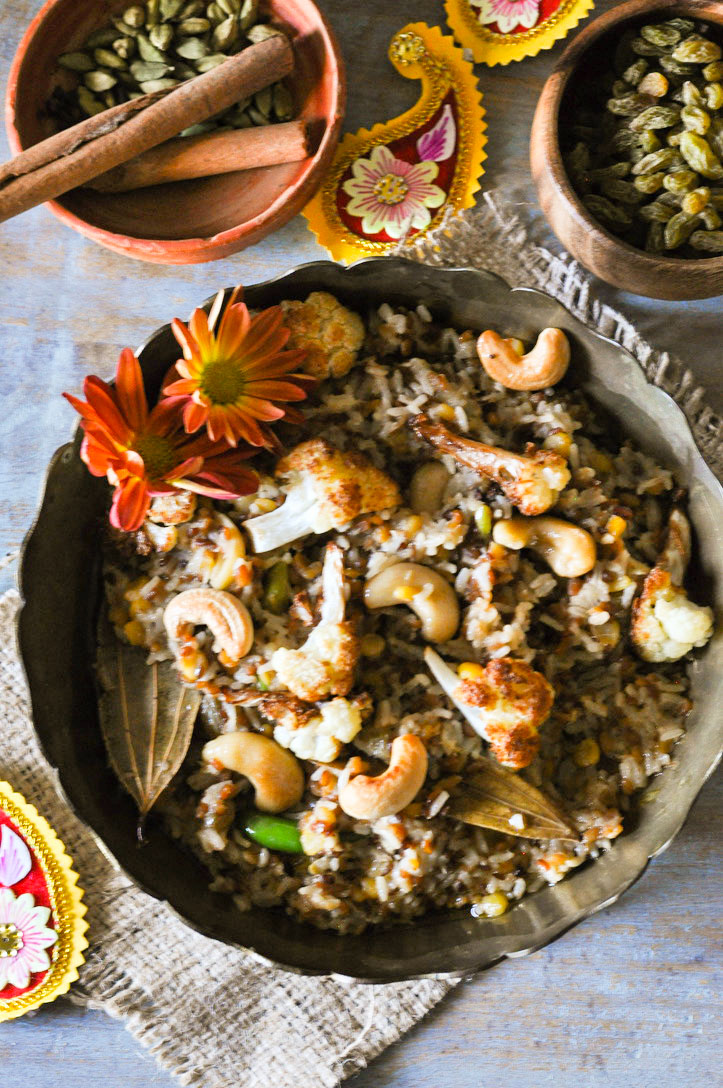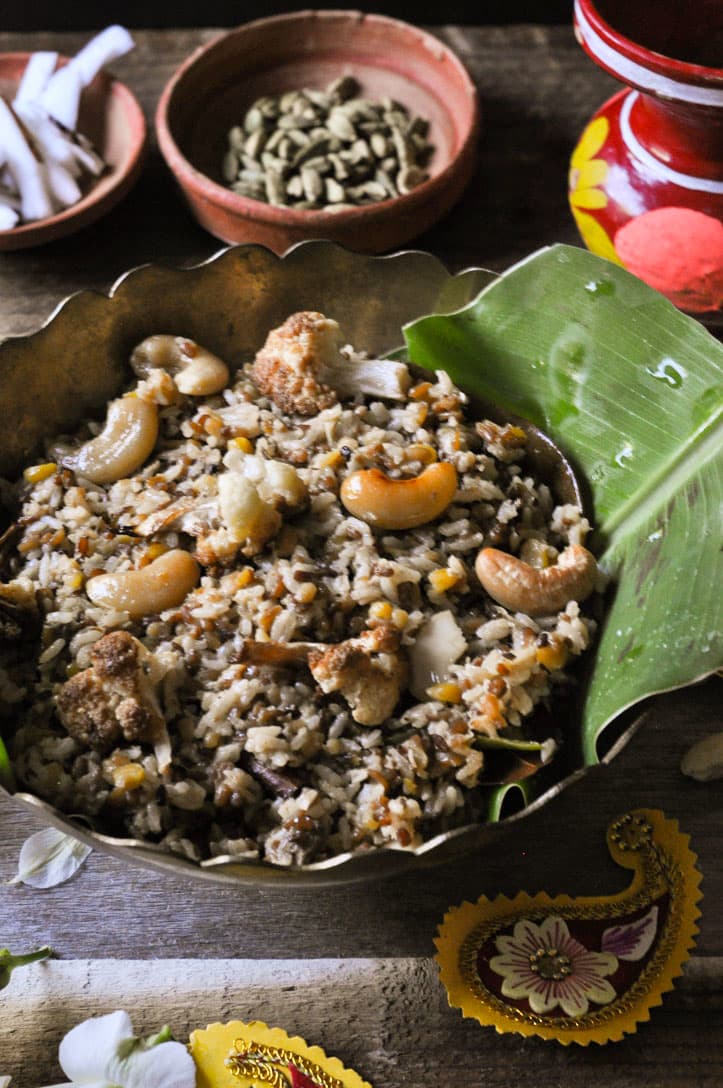
The Malai Jhuro Khicuri Recipe is an offshoot of our heirloom cult classic “the Jhuro Khichuri”. My dida or grandma was known far and wide for her Jhuro Khichuri recipe. Her Jhuro Khicuri was less of the ubiquitous mundane mushy yellow thing you may know of, and more of an exotic pulao. The grains would just bloom to perfection speckled with dried fruits and nuts, sweetened with grated coconut, perfumed with warm whole spices, and then stewed in a heady concoction of the best ghee in town and freshly pressed coconut milk. And this Malai Jhuro Khichuri would always be cooked in bell metal vessels, probably that too lent this dish a flavor of its own.
Malai Jhuro Khichuri Recipe
Print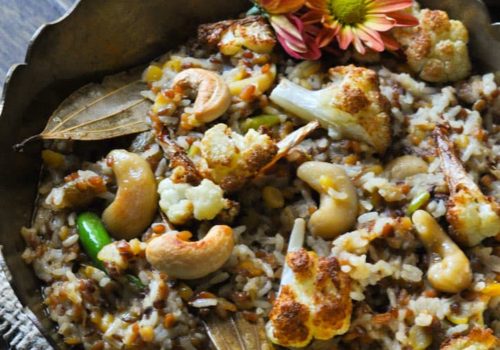
Malai Jhuro Khichuri
- Prep Time: 20
- Cook Time: 35
- Total Time: 55
Description
An extremely delicious variant of the khichuri/khichdi stewed in coconut milk and a melange of spices.
Ingredients
- Chana Dal-1/ 2 cup
- Mung Dal-1/ 2 cup
- Gobindobhog rice-1/ 2 cup
- Bay Leaf-2
- Cinnamon Stick – 1 inch
- Green Cardamom – 3-4, crushed
- Cumin Seeds-1 tsp
- Ghee-2 tbsp + 2 tsp
- Salt-To taste
- Sugar-To taste
- Mustard Oil-2 tbsp
- Grated ginger-1 tbsp
- Grated Coconut-3 tbsp
- Cumin Powder-2 tsp
- Coriander powder-2 tsp
- Kashmiri red chili powder-2 tsp
- Green chilies-2-3, slit lengthwise
- Small Cauliflower florets – 1 cup
- Cashews-2 tbsp
- Raisins-2 tbsp
- Coconut Milk – 1 cup mixed in 1 ½ cup of luke warm water
Instructions
- Soak the chana dal in 11/ 2 cups of hot water. Wash, rinse and then microwave for 10 minutes on high.
- Heat a pan and dry roast the mung dal over medium heat till it turns golden brown. This takes about 6-8 minutes. Constantly stir, otherwise the dal may burn and get black.
- Once done, wash and rinse the mung dal. Wash and rinse the rice.
- Now in a big mixing bowl, add the washed and rinsed chana dal, mung dal and rice.
- Add 1 tbsp ghee, 1 tbsp mustard oil, green chilies, grated ginger, grated coconut, 1 tbsp cashews, raisins, all the powdered spices, salt and sugar to taste. Mix well taking care not break the rice grains.
- In a pan, heat 1 tbsp of ghee and 1 tbsp of mustard oil, and fry the cauliflower florets and the remaining 1 tbsp of cashews till they are browned. Move aside.
- Now add bay leaves, cinnamon stick and cumin seeds and let it sputter and fragrant.
- Add the mix of dals and rice to the pan. Stir gently to mix. Keep stirring for 4-5 mins. Again, stir very gently so that the rice grains do not break and it does not stick to the bottom.
- After 5 mins or so, add the thin coconut milk and let it all come to a boil. Once it starts to boil, keep stirring gently and cooking it till the water reduces and reaches the level of the content of the pan. There will be still enough moisture but do not worry. Adjust the salt and sugar again at this point if necessary.
- Remove from stove and cover. Let it sit covered for a good 20 mins. Uncover, give it a stir and add 2 tsp of ghee, the cauliflower florets, fried cashews and enjoy.
Notes
- You can also garnish with deep fried thinly sliced coconut slices.
- Category: Rice
- Method: Cooking
- Cuisine: Indian
Nutrition
- Serving Size: 6
- Calories: 250
- Sugar: 0
- Sodium: 0
- Fat: 0
- Saturated Fat: 0
- Unsaturated Fat: 0
- Trans Fat: 0
- Carbohydrates: 0
- Protein: 0
- Cholesterol: 0
Keywords: Malai Jhuro Khichuri, Malai Jhuro Khichdi
Now talking about the grains, the rice used would be the small grained aromatic Gobindo Bhog that baba or dadu would bring home from the grocer after a fair amount of research and investigation tracing the origin of the produce. The dal too was of two kinds, the mung dal and the chana dal, again picked after severe scrutiny. There was a sense of immense fulfillment and flourish amongst the men in being able to source just the right ingredients for the malai jhuro khichuri recipe for dida.
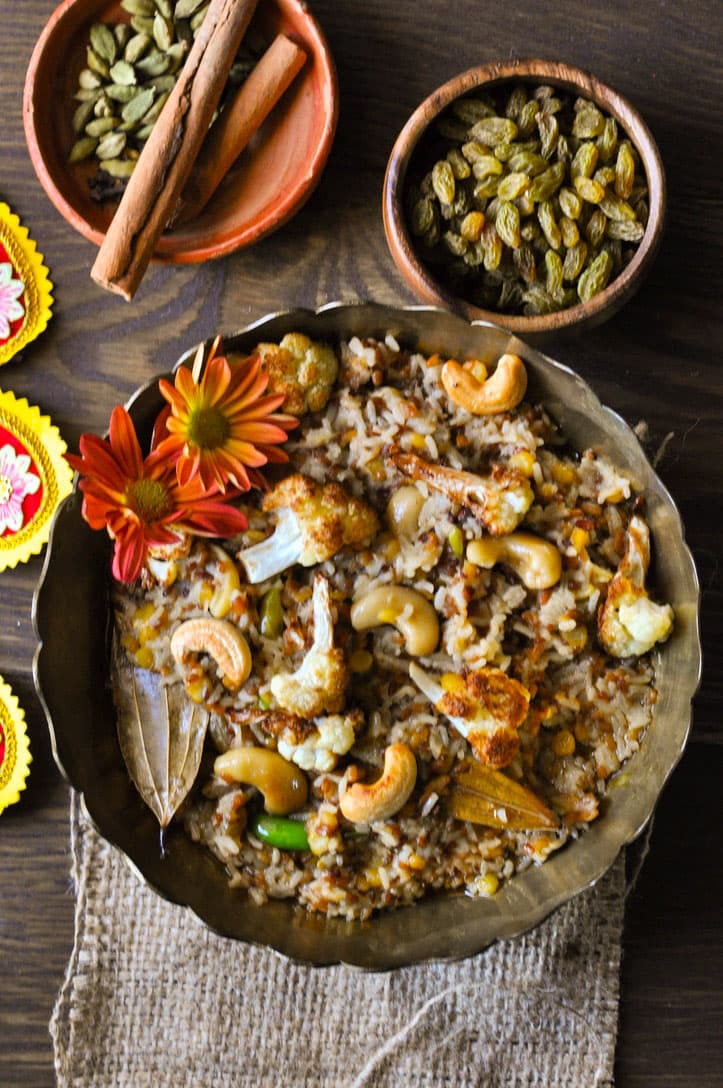
I think I have written about this before too, the earliest memory I have of my grandma’s house was that of her pantry, a tiny room which also doubled up as her puja room. There was an wooden bed frame in there without any upholstery and held various pots, pans, sacks and jars. Underneath the bed, at any given point of time one would find at least 20 unhusked coconuts picked from the trees around the house. Dida would take out one in two to three days, and get someone helping around the house to husk it for her. She would break it open very carefully while catching the water from it in a bowl. The fresh coconut water would be poured in glasses and handed to the grandchildren whoever happened to be around. The usage of coconut in our heirloom recipes is very significant quite understandably and that’s the inspiration behind this Malai Jhuro Khichuri Recipe too.
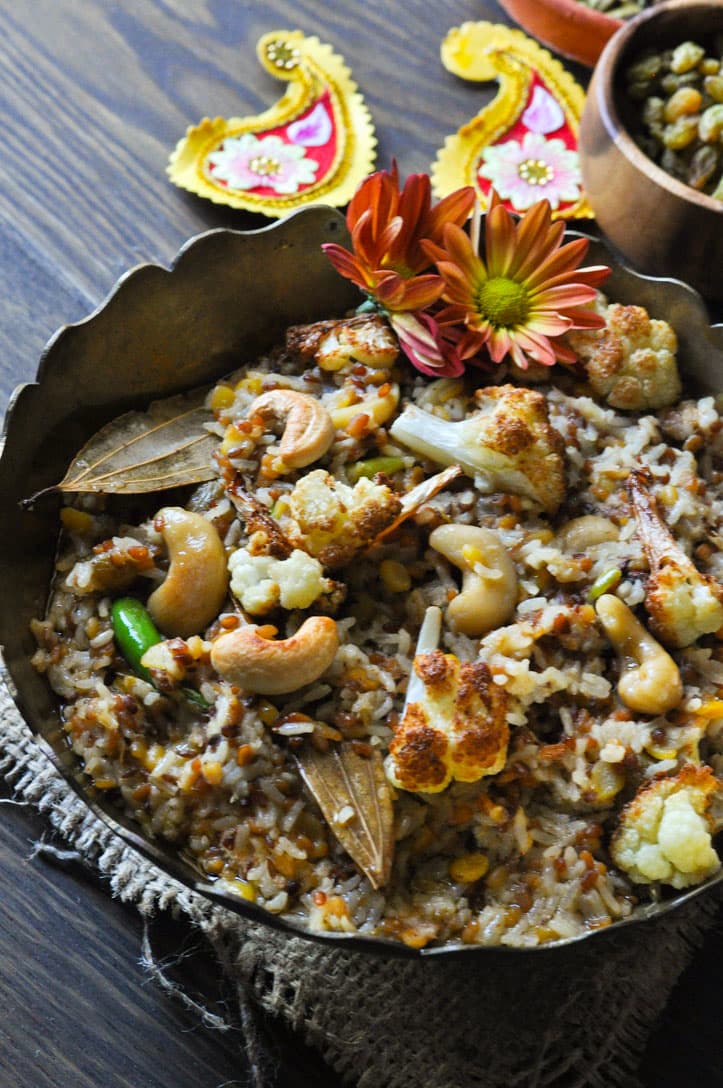
Any rice-based dish be it a pulao or a khichuri, would need some kind of a stock or as they say in Bengali “aakni” traditionally. In the case of this dish, the aakni used in the original recipe is the second pressed or repressed thin coconut milk. However, I always cook this with tinned coconut milk for obvious reasons. This particular Khichuri does not use any turmeric and hence white in color to a certain extent. The whole spices, ghee and the coconut milk along with a fair amount of mustard oil contributes to the heavenly alchemy in play for this dish.
I remember my dida would often use the word “mulam” in her conversations in her heavy Bangladeshi accent. This word would mean something soft and dainty almost like a feather and comes from the Hindi word “mulayam”. And whenever I try to imagine what I feel like with a spoonful of this khichuri in my mouth, it is this word that comes to my mind to describe that luxuriated feel of something rich and delicious yet with such a heavenly aftertaste.
This is now my go-to recipe especially if I am cooking a religious or a ceremonial meal. As Durga Puja is almost here, I can’t wait to make it again and I would definitely urge you to step up your normal khichuri with this Malai version here. You will love it!
You May Also Like
For all those of you trying to get a context, khichuri is essentially a porridge made with rice and lentils and is offered to the deities as a meal/bhog amongst Bengalis.
You may also like the recipes below:

